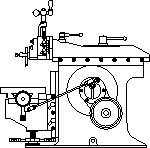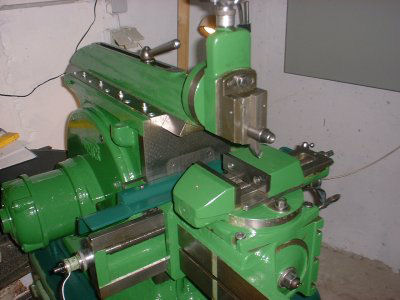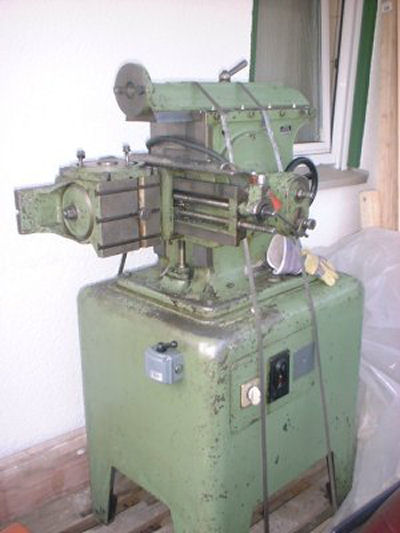

This month’s shaper story is about the refurbishing of a German shaper made by the Ludwig Gack Machine Works company. The following is pretty much a cut and paste from the owner’s excellent web site and article at: www.schmidt.ath.cx/mechanik/stossmaschine.shtml
The translation from German to English was done by Andreas Miler and it is with the author Siegfried Schmidt’s generous permission that we have the following story:

Ludwig Gack Shaper
Photo by Siegfried Schmidt
“My newest acquisition is a horizontal shaper, also named “Schnellhobler“ or “Kurzhobler” (quick planer or short planer). By definition, these names are wrong, because for a planer, the work piece moves not the tool itself.
My Type 152 shaper, built by Ludwig Gack Machine works in 1952 is still going strong, even though it has 52 years on it now.
Other information on this manufacturer is quite rare. The only other online sources are hidden over the great pond.
The following link is an outstanding homepage on the restoration of another Gack Shaper, different from mine. It goes into depth with pictures and movies. On the accessories pages, you get an idea of what was done with these machines. www.csparks.com/Gack/index.xml
If someone knows about my machine or has literature and documentation, please contact me at siegfried@schmidt.ath.cx. I’d be happy to receive any tips.
I bought the machine blind, in a severe attack of iron deficiency. I had no clue about size, weight, nor did I have an idea how to move this piece of iron into my basement to reassemble it there. I had quite a nervous feeling during transport and loading/unloading of the machine.
Below is a photo from the Internet ad for the machine. When I finally saw the machine, my impression was a little bit more favorable.

Photo from web ad
Photo source unknown
When the machine and I touched home soil, all the doubts had faded away. The machine was secured in a more serious way during transport. The guy who gave his trailer to me muttered when I asked him for two additional load straps. In his words, two were quite enough to bend the aluminum body of the trailer.

Shaper Arriving
Photo by Siegfried Schmidt
To move the top heavy shaper out of the trailer and onto the ground without a crane proved the biggest problem of the whole transport. After unloading, a sigh of relief gave me the feeling that this had been the hardest part of the whole operation.

Less Vise & Clapper
Photo by Siegfried Schmidt
The vise and tool head were the first dismantled parts that went into the basement. Quite heavy, but somehow the shaper didn’t get much lighter.
The motor which is attached to the gear was the next part I took off. Here, I found screws in top condition. All the hardware was reused later on!

Gear under Motor
Photo by Siegfried Schmidt
Grease wasn’t in short supply for this machine, for sure! A clump of a few centimeters and these nice grapes had accumulated in the machine during the past 50 years. In every hole, I found grease. Very good, so the rust had no chance at all.

Grease Not Rust
Photo by Siegfried Schmidt
After removal of the crank and of the base, the single heaviest part, the machines body, remained. Screwed on two by fours, a sled was formed to get the machine downstairs. As a gliding aid, corrugated cardboard was used. Getting the machine down was no problem afterwards.

Body on Sled
Photo by Siegfried Schmidt
The base itself includes no parts of the machine, except the two switches. It’s made of 6mm thick steel plates. Therefore, it’s quite light. I used the sled approach again.
The electrics of the machine were altered quite often. The only thing still original was the black overload protection. The grey switch to the left was added later on and the white switch is a switch for the Dahlander motor, which can be set for two operation speeds.
The rest of the electrics were in a grim condition. It was a mix of wires, massive and flexible, held together with luster terminals.
The Motor can be driven in two directions with two speeds. It needs three-phase power.”

Base
Photo by Siegfried Schmidt
Next month we will continue with the rework of Siegfried Schmidt’s Ludwig Gack Shaper.
Keep sending me email with questions and interesting shaper stories.
My email address is KayPatFisher@gmail.com.